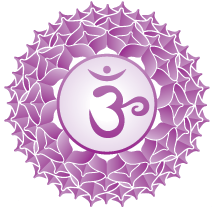The Seventh Chakra - Sahasrara

Element: Spirit/Thought
Colour: Violet/white
Gemstones: charoite, sugilite/luvulite and emerald (to calm) celestite and blue sapphire to activate and clear quartz or amethyst to balance.
Emotion: Beingness, unity, inner wisdom
Oils: Ylang Ylang, rosewood, linden.
Body Sense: All
Mantra: “May I have a clear and open connection with my spirit and live in the present moment.
Sanskrit seed symbol: ‘Om’
It is important to note that the three major chakras below the heart are principally concerned with the physical body and the world we perceive with our senses, whereas those above the heart are of a more spiritual level. [1]
The seventh chakra (or crown chakra) is called Sahasrara and it is located at the top of our head. The crown chakra is also known as the Thousand-petalled Lotus, sahasrara padma, pankaja and shuddha padma. Sahasrara also translates as ‘a thousand petals’.
We first balance the lower chakras to elevate us toward the ultimate goal of balancing and opening the crown chakra to uncover enlightenment, self-realisation, fulfilment and divine self.
Sahasrara is the place of pure consciousness. From subtle anatomy we know that it is at the end of the main sushumna nadi, where it combines with the energies of the pingala nadi (solar and masculine energy) and the ida nadi (lunar and feminine energy) that have conjoined at Ajna during the rising of kundalini. The Crown Chakra symbolises the balance of duality within us and our ability to experience super-consciousness, and then the bliss of transcendental consciousness... Perhaps the best way to begin to understand it is to enter regularly into deep meditation, where you let go of everything and all is peace. [2]
“Remember the entrance door to the sanctuary is inside you.” ~ Rumi.
The seventh chakra is concerned with spiritual growth, wisdom, union, divine connection, insight, equanimity, awakening and enlightenment.
Sahasrara leads you beyond materialism to the true nature of life which is abundant in joy, purpose and curiosity. [3]
When the crown chakra is under active, it can lead to frustration, feelings of abandonment, materialism, low energy and a lack of joy.
When the crown chakra is over active, it may lead to being self-centred, narrow minded and feel spiritually superior to others.
The pituitary and pineal glands are associated with the Crown Chakra and diseases connected with the 7th Chakra are: headaches, epilepsy, paralysis, Parkinson’s Disease and High Blood Pressure.
To balance the chakras you can practice specific yoga poses to encourage balance, use oils for the 7th Chakra (inhaled or anointed), lay specific gemstones directly on your chakra and/or visualise a wheel of light in the chakra’s colour (violet/white), spinning in a counter clockwise direction to cleanse and in a clockwise direction to strengthen.
Other ways to balance the crown chakra are to connect with your inner self through yoga, meditation and contemplation. Write down your dreams and imaginations and anchor yourself to the present moment.
The most beneficial yoga poses are:
· Headstand (Salamba Sirhasana 1)
. Crow/Crane Pose (Bakasana)
. Shoulder stand (Salamba SArvangasana 1)
. Half Lotus (Ardha Padmasana)
. Corpse Pose (Savasana).
Questions to ask your-self related to the crown chakra:
· How do I connect with the divine that dwells within me?
. What guidance have I sought during meditation or prayer?
· When and where do I feel a sense of union with my higher self?
· Do you believe that your God is more authentic than the Divine in other spiritual traditions?
. How can I continue along the path of enlightenment without grasping or getting stuck?
· Have you started and stopped a regular meditation practice? Why?
Notes:
1 & 2. The Chakra Bible by Patricia Mercier.
Chakras 1 – 6: Find out about any chakra’s you have missed at Spirit Yoga news/blog here.
Chakra Jewellery: http://www.chakra.net.au/
Article by Martine Ford




